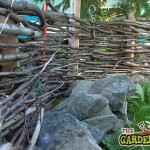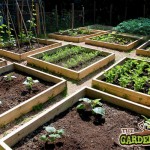All that stands between a bountiful crop and a determined gardener is the plot which he has to work with. There are a number of elements to consider when looking over your plot and assessing its suitability to grow potatoes and other vegetables.
Size: How big is your plot? For a family of 4 you would need at least 90 Sq metres. This size would allow you to have 6 decent sized beds (15 Sq metres) with room for paths up the middle, dividing the beds.
- potatoes
- Enclosure
- Vegetable garden
Layout: When growing vegetables it is best to divide your plot into 6 evenly sized sections. You can divide your plot simply using garden twine or more elaborately and permanently by laying a block paved edge. These sections will become your crop rotation sections over the coming years. With 6 areas you can have a specific area for growing brassicas, onion family, root crops, legumes, a section for seed potatoes and a bed for permanent crops such as rhubarb and fruit bushes.
Measure the area you have chosen and using a garden twine divide it out into 6 beds. Ideally a vegetable bed should be 3 metres in width as this is a workable size and sufficient row size for growing crops. A 3 metre long row would allow you grow 5 to 7 potato plants. There are two obvious shapes that you can use; a square patch or a rectangular patch. For a rectangular patch of 3 M in width you would need a minimum length of 18 M. However this does not allow for paths.
Enclosures: One thing that a vegetable patch needs is shelter. Shelter from the wind is essential for strong and healthy crops. Wind can cause vegetables such as cabbage and broccoli to bend and break. Wind can also lead to scorching of plants and may cause them to dry out too fast. Wind is also a carrier of fungal infections such as potato blight. The position of your plot with determine how windy it is however there are a number of ways in which you can reduce the plots exposure to the wind.
First avoid positioning your vegetable garden in an open and unprotected area. You can also plant a taller hedgerow along the northern side of the plot as this will provide shelter from the coldest of winds without shading out your plot. On the three remaining sides you can erect a low fence of screen. These can be wind barriers, willow fencing, or similar, so long as they are no more than 4ft in height they shouldn’t cast too much of a shadow. Lastly you can plant rows of peas and beans along the wind ward side of your plot to provide additional shelter to your potato and other crops.


